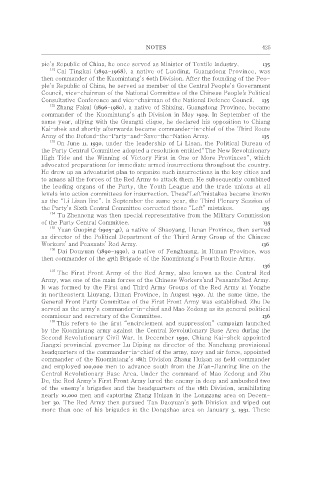Page 429 - SELECTED WORKS OF ZHU DE
P. 429
NOTES 425
pie’s Republic of China, he once served as Minister of Textile Industry. 135
131 Cai Tingkai (1892-1968), a native of Luoding, Guangdong Province, was
then commander of the Kuomintang’s 60th Division. After the founding of the Peo-
ple’s Republic of China, he served as member of the Central People’s Government
Council, vice-chairman of the National Committee of the Chinese People’s Political
Consultative Conference and vice-chairman of the National Defence Council. 135
Zhang Fakui (1896-1980), a native of Shixing, Guangdong Province, became
132
commander of the Kuomintang’s 4th Division in May 1929. In September of the
same year, allying with the Guangxi clique, he declared his opposition to Chiang
Kai-shek and shortly afterwards became commander-in-chief of the Third Route
Army of the Defend-the-Party-and-Save-the-Nation Army. 135
133
On June 11, 1930, under the leadership of Li Lisan, the Political Bureau of
the Party Central Committee adopted a resolution entitled “The New Revolutionary
High Tide and the Winning of Victory First in One or More Provinces”, which
advocated preparations for immediate armed insurrections throughout the country.
He drew up an adventurist plan to organize such insurrections in the key cities and
to amass all the forces of the Red Army to attack them. He subsequently combined
the leading organs of the Party, the Youth League and the trade unions at all
levels into action committees for insurrection. These “Left” mistakes became known
as the “Li Lisan line”. In September the same year, the Third Plenary Session of
the Party’s Sixth Central Committee corrected those “Left” mistakes. 135
134 Tu Zhennong was then special representative from the Military Commission
of the Party Central Committee. 135
135
Yuan Guoping (1905-41), a native of Shaoyang, Hunan Province, then served
as director of the Political Department of the Third Army Group of the Chinese
Workers’ and Peasants’ Red Army. 136
Dai Douyuan (1890-1930), a native of Fenghuang, in Hunan Province, was
136
then commander of the 47th Brigade of the Kuomintang’s Fourth Route Army.
136
137
The First Front Army of the Red Army, also known as the Central Red
Army, was one of the main forces of the Chinese Workers’ and Peasants’ Red Army.
It was formed by the First and Third Army Groups of the Red Army at Yonghe
in northeastern Liuyang, Hunan Province, in August 1930. At the same time, the
General Front Party Committee of the First Front Army was established. Zhu De
served as the army’s commander-in-chief and Mao Zedong as its general political
commissar and secretary of the Committee. 136
138 This refers to the first “encirclement and suppression” campaign launched
by the Kuomintang army against the Central Revolutionary Base Area during the
Second Revolutionary Civil War. In December 1930, Chiang Kai-shek appointed
Jiangxi provincial governor Lu Diping as director of the Nanchang provisional
headquarters of the commander-in-chief of the army, navy and air force, appointed
commander of the Kuomintang’s 18th Division Zhang Huizan as field commander
and employed 100,000 men to advance south from the Ji’an-Jianning line on the
Central Revolutionary Base Area. Under the command of Mao Zedong and Zhu
De, the Red Army’s First Front Army lured the enemy in deep and ambushed two
of the enemy’s brigades and the headquarters of the 18th Division, annihilating
nearly 10,000 men and capturing Zhang Huizan in the Longgang area on Decem-
ber 30. The Red Army then pursued Tan Daoyuan’s 50th Division and wiped out
more than one of his brigades in the Dongshao area on January 3, 1931. These

